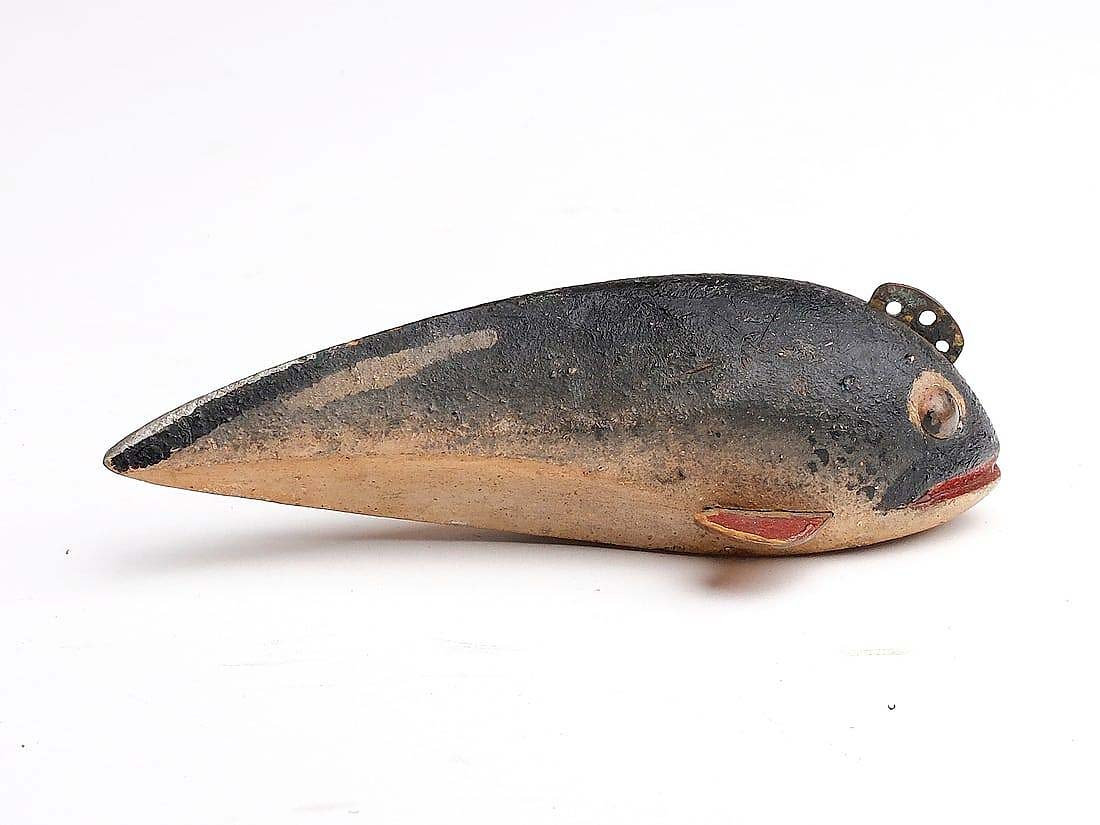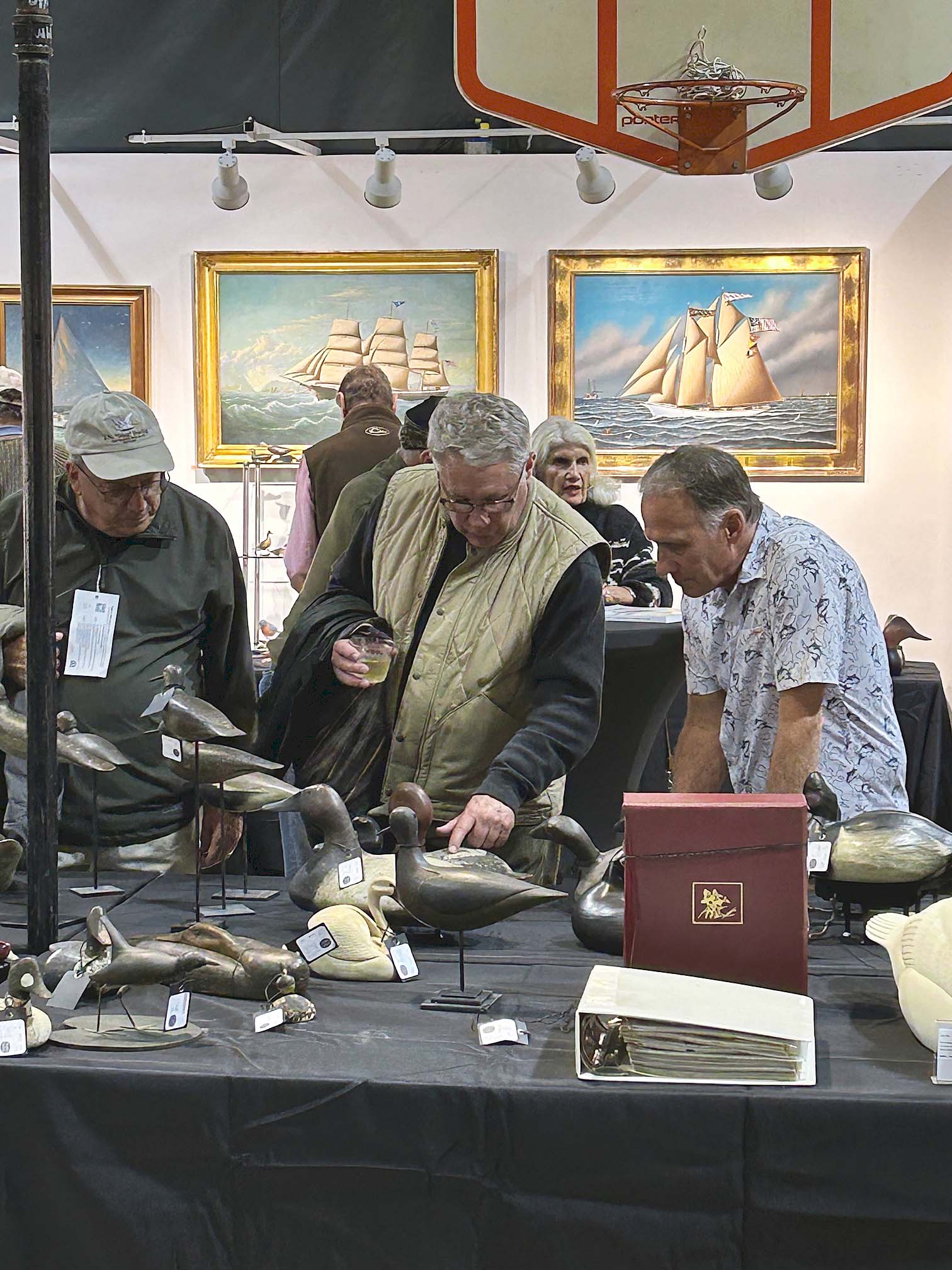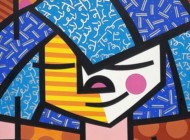
This Ward Brothers “pinched breast” pintail hen was the star of the sale, finishing at $84,000. “Pintail female 1931” was written in pencil on underside. This decoy had never been offered at auction before.
Review by Rick Russack; Photos Courtesy Guyette & Deeter
EASTON, MD. — An example of good planning in conjunction with the Easton Waterfowl Festival, Guyette & Deeter conducted its November 11-12 live auction. That festival, one of the largest of its kind, attracts 14,000 interested visitors. The auction included 550 lots featuring the collections of David Fannon and Joel Barber. Before the sale, Jon Deeter said, “We’ve had strong presale interest in the three birds that were deaccessioned by an East Coast museum, which has decided to concentrate its collecting on birds of their region. Those would be the Horner mallard, the Parker merganser and the John English mallard. There isn’t much on the market from the hand of Joel Barber, [author of the first book on decoy collecting] so I’m not surprised at the interest in his swan watercolor.”
The sale grossed $2.3 million, with more than 60 lots bringing five-figure prices. There was also a 50-table decoy show in conjunction with the auction.
There were several Ward brothers decoys, very appropriate to the Chesapeake Bay setting of this sale. There were 18 works by Elmer Crowell, along with numerous other shore bird decoys. There were decoys by dozens of other carvers as well as factory birds. In addition to championship carvings, there was a large selection of decorative carvings by other makers, trophy fish carvings and many more. Sporting art included major works by James Brade Sword, Edmund Osthaus, Lynn Bogue Hunt, A.B. Frost and others. Folk art included weathervanes, cigar store Indians and a group of walking sticks.

The largest known relief carved wall plaque of a great horned owl by Oscar Peterson sold for $39,000. It was 26 inches tall, carved from a board about 1½ inches thick.
A new category for Guyette and Deeter sales was the addition of a group of prize-winning carvings from the Ward World Carving Championships and carvings commissioned directly from those artists. Many were from Toronto collector Giovanni Lamenza. Many represent hundreds of hours of work and are the very best examples the artists have produced. A 1991 standing preening blue-wing teal drake by Pat Godin sold for $19,200. He has won many awards from those championship contests. A 1994 life-sized pileated woodpecker by Larry Barth, Stahlstown, Penn., sold for $14,400. In 2015, Barth won the title of “Best in World.” One of the most colorful and eye-catching carvings was a pair of green herons by Gary Yoder, Garret County, Md. The carvings depicted an alert pair of birds perched on a partially submerged root with carved wooden lily pads. This piece won the first best of show award at the world championship contest in 2001. It sold for $12,000. There were several more. In some cases, the artist first sketches what he is planning to create, then makes a clay sculpture and then starts to carve. Deeter commented, “This a new category for us and we’ve been promoting these works to the community that’s interested. Up until now, there hasn’t been an established secondary market for these carvings — that’s a niche we’d like to fill. We’ll see what happens.” Lora Bottinelli, former director of The Ward Museum, provided some additional information on the championship pieces. The printed catalog includes extensive biographical information on the artists who created these works. It’s worth taking a few minutes to look closely at the online photos of these carvings. The detail is amazing.
It’s unfortunate that the constraints of the online bidding platforms do not allow for the inclusion of the extensive biographical essays that are part of the printed catalogs. Those essays, of which there are many, include so much more information than the online listings do. The additional information makes the catalogs important reference works and easily justifies their purchase.

A new category for Guyette and Deeter sales was the addition of a group of prize-winning carvings from the Ward World Carving Championships, and they were well received by collectors. A 1991 standing preening bluewing teal drake by Pat Godin sold for $19,200.
Jon Deeter often begins the firm’s sales with carvings that he expects will do well, and he did that this time. Lot #1 was a pinched-breast pintail hen created by the brothers Lem and Steve Ward of Crisfield, Md., circa 1931. These decoys have a distinctive body style and were made only for a limited number of species. This is one of those instances mentioned above; the catalog devotes a full two pages to describing this decoy while the online description is only four lines long. The decoy sold for $84,000. While many decoy carvers basically produced decoys in one style, the Ward Brothers’ work evolved over time, and they used a variety of styles, including decorative miniatures. There were more than two dozen Ward Brothers birds in this auction, and another earned the second highest price of the day. The brothers created a sleeping mallard drake for the 1948 National Decoy Makers Contest, conducted at the National Sportsman Show New York City. It was declared “Best in Show” and was awarded an engraved silver trophy and ribbon. Both accompanied this decoy, which sold for $72,000. Three of the other Ward Brothers decoys sold for more than $10,000 each, while three of their miniatures could be had for less than $1,000 each.
One of the three birds that had been deaccessioned by an East Coast museum that Deeter thought would do well, did just that. A mallard drake by John English, Florence, N.J., sold for $39,000. According to the extensive description in the catalog, English is believed to have probably not produced more than 500 birds in his lifetime. This mallard was hollow-carved and had detailed feather carving and raised wing tips. Another of that group, a rare red breasted merganser with an extended crest by Lloyd Parker, Parkertown, N.J., sold for $23,400. The third one of that group, a mallard drake by Nathan Rowley Horner, West Creek, N.J., sold for $31,200.
Given the location of the sale, it should not be surprising that there were more than 80 decoys that related to Chesapeake Bay and the region. The Ward Bothers selection was part of this group but not the only ones to do well. A high-head canvasback hen by Charles Nelson Barnard, Havre de Grace, Md., dating to the early years of the last century, brought $33,600 and his rig-mate pair of canvasbacks brought $13,200. There were ten decoys by John Holly, also from Havre de Grace. A possibly unique hollow-carved mallard earned $30,000, and a red headed hen by the same maker earned $3,300. From the same region, there were three turtles by contemporary carver Eddie Wozny, Cambridge, Md. An eastern box turtle earned $4,800, a miniature Eastern painted turtle earned $4,200, and a diamond-back terrapin earned $1,500.

Contemporary carvings by Frank Finney have been doing very well at auction recently, and there were several in this sale. This friendly, folky, life-size otter with applied metal whiskers reached $32,400.
Contemporary and decorative carvings continue to do well. This discussion has to include works by Elmer Crowell, Frank Finney and Mark McNair, although there were carvings by several others. It might be expected, given his recent market performance, that carvings by Frank Finney would lead this category. That would be a correct assumption. Standing 29 inches tall, a life-size otter by Finney led the category, selling for $32,400. The whimsical otter, initialed on the base, with applied metal whiskers, was extending a tray with a turtle shell. The catalog has three close-up photos of the otter and a statement by Finney about it. His 25-inch-tall bird tree with flowering magnolias and three ruby throated hummingbirds sold for $22,800. Secure on one branch of the tree was a nest with two eggs. There were 16 other carvings by Finney.
There were 25 carvings by Elmer Crowell, with a decorative Baltimore oriole leading the way, selling for $31,200, far above the estimate. His full-size cardinal and robin each sold for $11,400. The 11 lots of decoratives by Craddockville, Va., carver Mark McNair were topped by a group with three running curlews, which brought $5,100.
This and the recent Guyette and Deeter sales offered large selections of sporting art. Consistently doing well are paintings of hunting scenes and paintings of dogs. So it was this time, as an oil on canvas by Edmund Henry Osthaus (1858-1928) of two English setters on point was the most popular of the sporting art offerings, realizing $39,000. Not far behind it, realizing $37,200, was a James Brade Sword (1839-1915) oil on canvas titled “Duck Shooting: Chesapeake Bay.” Dated 1883, it depicted two hunters with shotguns aimed at an incoming flock of ducks. As mentioned earlier, there were works from the hand of Joel Barber (1877-1952), who wrote the first book on decoy collecting. His collection is at the Shelburne Museum, and few of his things turn up for sale. Included in this sale was a watercolor painting he did, signed and dated 1950. It was of the “Havre de Grace” or Holly swan, as it is now known, and brought $19,200. There was also a canvasback made by Barber. It was signed on the bottom, “model made by Joel Barber 1940.”

Paintings of hunting dogs always seem to do well. Two English setters on point by Edmund Henry Osthaus realized $39,000, the highest price of the sporting paintings.
After the sale, Jon Deeter said, “Working with the Waterfowl Festival really worked for us. We had a large, very social crowd for the previews and we saw some younger people. That crowd comes to spend some money and we were glad to see them. I didn’t know what to expect from the world championship carvings, and I was pleased to see the number of interested buyers, even though in some cases, they sold below our estimates. It’s a good market, we’re feeling our way, and we’re planning to go after those birds. The 50-plus dealers at our decoy show said they did well and several have already signed up for next year. In general, the sale went pretty much as we expected it would. There weren’t any big surprises at either end of the price range. And you can never be unhappy with a $2.3 million gross. We’re looking forward to our sale of the Alan Haid collection. That will be a barn-burner.”
Prices given include the buyer’s premium as stated by the auction house. For more information, www.guyetteanddeeter.com or 410-745-0485.






















